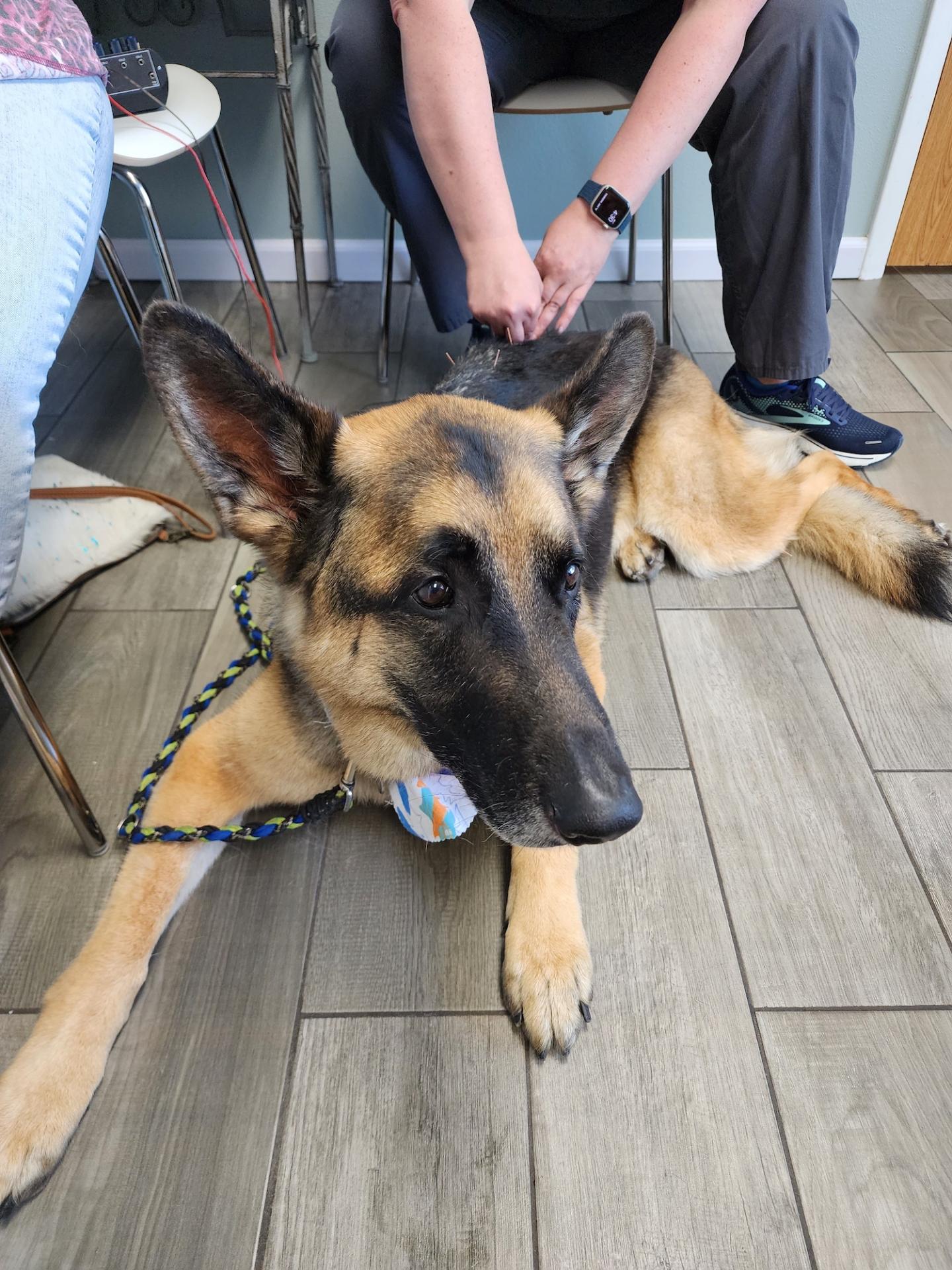How does acupuncture impact the wellbeing of my cat or dog?
Veterinarians that are trained to perform acupuncture will tell you that they think of acupuncture as one of the many tools at their disposal. Acupuncture offers a safe method to manage both acute and chronic pain, as well as other ailments, in both cats and dogs. It is noninvasive and not a frightening experience for cats or dogs.
Is there more than one type of acupuncture for my dog or cat?
 While there are a few different types of acupuncture, the two most common and most effective in veterinary medicine are dry needling and electroacupuncture. Both of these are performed at Family Pet Veterinary Centers. Dry needling, which is what the most basic form of acupuncture is referred to, is when an acupuncture needle is inserted at a trigger point. Trigger points are the painful places identified on the dog or cat during the exam performed prior to starting acupuncture.
While there are a few different types of acupuncture, the two most common and most effective in veterinary medicine are dry needling and electroacupuncture. Both of these are performed at Family Pet Veterinary Centers. Dry needling, which is what the most basic form of acupuncture is referred to, is when an acupuncture needle is inserted at a trigger point. Trigger points are the painful places identified on the dog or cat during the exam performed prior to starting acupuncture.
Another common form of acupuncture is called electroacupuncture; which is the most common type of acupuncture we perform at Family Pet Veterinary Center. During electroacupuncture the veterinarian places acupuncture needles in the pet’s trigger points or sites surrounding the problem area(s), then a gentle electrical current is applied to a select few of the acupuncture needles to promote stimulation. As veterinarians are trained to do this, they commonly learn to perform this procedure on themselves ensuring ease and painless manner of application.
How old should a cat or dog be to get acupuncture?
While acupuncture is more commonly used in older cats and dogs, there is no minimum age when a cat or dog can begin receiving treatment and it is not harmful to use in young pets such as puppies and or kittens. Since each cat and dog are different and acupuncture can treat a variety of ailments it is best to speak with your veterinarian to see if this form of treatment is best for your cat or dog.
What are some conditions that you can treat with acupuncture?
- Acute and chronic wounds
- Surgical incisions
- Burns or abrasions
- Lick granulomas
- Local dermatitis
- Local injury to joints, muscles and other soft tissues
- Intraoperative and postoperative surgical pain
- Traumatic injury
- Dental procedure pain
- Intervertebral disk disease (IVDD)
- Osteoarthritis
- Chronic back pain
- Neuropathy
- Painful internal organ conditions
- Orthopedic surgery and injury
- Peripheral nerve injury
- Head tilt, or a stiff neck
Would acupuncture complement my cat or dog’s current Western Medicine treatments?
Acupuncture is often used in Western Medicine in conjunction with surgery and/or medications. In select cases acupuncture can be a successful alternative to a surgical procedure. It is a safe way to treat a plethora of conditions as well as acute and chronic pain. Not only is it minimally invasive, but also has a minimal risk for adverse reactions. In studies, patients were more likely to report adverse event from placebos than acupuncture.
Is acupuncture stressful for my pet?
Visiting your veterinarian’s office can be stressful for your pet even if they aren’t in pain. With our free fear techniques we can help lessen the stress of not only visiting for routine appointments but for acupuncture visits as well. Many times we play calming music during the session which has been shown to aid in anxiety reduction.
How do I know if acupuncture is right for my cat or dog?
The best way for you to determine if adding acupuncture to your cat or dog’s pain management plan is to talk to your veterinarian.
Contact us today to see if acupuncture can help your cat or dog live a more painless life.
Read “Bella’s Story” which tells the story of how Bella benefited from acupuncture and laser therapy to regain the ability to walk again at the young age of 4 years!
Bella’s Story
November 2008, I stopped at Iowa Pet Food and Aquatics to donate some newspapers for their kennels that contained ARL rescue animals; I met this little yellow dog, believed to be a ‘Morkie’ named Lacey and it was love at first sight! Within a few hours, I returned to the store and decided to adopt that little dog and I was quickly on my way home. She became Bella shortly after that and she was a very happy, easy and loving member of our family. At approximately 4 years of age, Bella developed pain and difficulty in walking to the extent that she lost the use of her back legs. Our veterinarian, Dr. Jennifer Mathis, advised us that surgery was an option, but first she recommended that we try a series of acupuncture and laser treatments in addition to steroid injections as a less invasive treatment choice. Bella had initial acupuncture and laser treatments multiple times daily for about 2 weeks and after following Dr. Jen’s protocol, Bella regained the use of her back legs! We created some at-home modifications to continue to help Bella in the rehabilitation process. In addition to that, we built a rehabilitation tool to help strengthen Bella’s back and legs. This tool consisted of a ladder constructed of lengths of PVC piping that laid flat on the ground. We would prompt Bella to step through it over and over again. She eventually regained the use of her back legs. Later in Bella’s life she did endure a few setbacks, which is to be occasionally expected. The challenges that Bella experienced later in life prompted us to increase acupuncture, laser therapy, and steroid injections but those treatments allowed us to continue to give Bella a great quality of life. Bella ultimately gave us 14 wonderful years filled with love and joy and we still miss her dearly. We are so grateful that Dr. Jen was able to help us create a quality life for Bella despite her challenges in her younger years. Ultimately we recognize that with acupuncture and laser therapy we were able to give Bella what she needed to maintain a happy and healthy life without a surgical procedure and Bella was able to maintain her mobility for the remainder of her long life. -Judy and Larry
